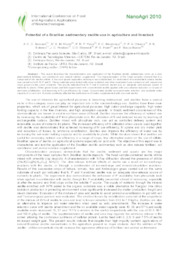Potential of a Brazilian sedimentary zeolite use in agriculture and livestock.
Potential of a Brazilian sedimentary zeolite use in agriculture and livestock.
Author(s): BERNARDI, A. C. de C.; MONTE, M. B. M; PAIVA, P. R. P.; MENDONCA, F. C.; OLIVEIRA, P. P. A.; ESTEVES, S. N.; POLIDORO, J. C.; WERNECK, C. G.; HAIM, P. G.; SOUZA-BARROS, F.
Summary: The use of minerals for agricultural purposes is becoming widespread, and zeolites have a special niche in this category since can play an important role in the nanotechnology era. Zeolites have three main properties, which are of great interest for agricultural purposes: high cation exchange capacity, high water holding capacity in the free channels, and high adsorption capacity. In Brazil, sediment occurrences of this aluminosilicate are known to exist in northern areas of Brazil. Zeolites improves the efficiency of nutrient use by increasing the availability of P from phosphate rock, the utilization of N and reduced losses by leaching of exchangeable cations. Zeolites mixed with phosphate rock, can act as controlled delivery system and renewable source of nutrients for plants. The increased efficiency of N utilization when urea is used together with zeolite was demonstrated that achieved increasing of N use efficiency, N uptake and dry matter yield and reductions of losses by ammonia volatilization. Zeolites also improve the efficiency of water use by increasing the soil water holding capacity and its availability to plants. While literature shows that zeolites are useful for increasing nutrient use efficiency in a range of crops, few information exists on the use of stilbite, Brazilian specie of zeolite, on agricultural systems especially on acid soils. The objective of this report was to characterize and test the application of the Brazilian zeolitic sedimentary rock as slow release fertilizer, soil conditioner and animal nutrition supplement. Characterization analyses demonstrate that the zeolitic sediment and quartz are the major components of the head samples from Brazilian zeolite deposits. The head sample contained zeolite stilbite mixed with smectitic clay deposits. A characterization with X-Ray diffraction showed the presence of stilbite ((Na,K)Ca2[Al5Si13O36] .14H2O). The slow-release fertilizer effects of zeolite are a result of ion-exchange reactions with the zeolite, or through a combination of ion-exchange and mineral-dissolution reactions. Results of the successive crops of lettuce, tomato, rice and Andropogon grass carried out on the same substrate of each pot indicated that N, P and K enriched zeolite was an adequate slow-release source of nutrients to plants. The experiment also demonstrated the enhanced of P availability from phosphate rock when applied in combination with zeolite, though the P availability presented a trend of increasing, especially at after the second and third crops unlike the soluble P source. The supply of nutrients through the mineral zeolite enriched with NPK added to the organic substrate was a viable alternative for Rangpur lime citrus rootstock production in protecting environment since significantly increased dry matter production, height and steam diameter. Evaluation of the mixture of urea and zeolite to avoid ammonia volatilization in pot with soil and Tanzania-grass pasture was evaluated. The smallest losses by volatilization occurred at the proportions of the mixture of 25% of zeolite to urea and lead to losses reduction from 33.5 to 7.6 kg/ha. Zeolites are also an alternative to improve soil water retention when used as soils amendments. The increase in water retention curve with zeolite amendment and the on available water capacity were 10, 38 and 67% and easily available water increased 15, 51 and 111% in relation to the control respectively with the use of 33.3; 66.7 and 100.0 g/kg of zeolite. The supplementation of zeolite and urea may regulate the ammonia release in the rumen allowing the continuous synthesis of cellular protein. Lambs feed with 0, 2,5; 5 and 7,5% of zeolite increased weight gain. The present results indicate that despite their high-impurity content; applications of natural Brazilian zeolitic concentrates in the agriculture present no major obstacle. And the addition of the zeolite - stilbite concentrate should increase the agronomic efficiency of fertilizer and animal performance.
Publication year: 2010
Types of publication: Abstract in annals or event proceedings
Keywords: Agricultura, Confinamento, Nutrição, Planta, Zeolite
Observation
Some of Embrapa's publications are published as ePub files. To read them, use or download one of the following free software options to your computer or mobile device. Android: Google Play Books; IOS: iBooks; Windows and Linux: Calibre.
Access other publications
Access the Agricultural Research Database (BDPA) to consult Embrapa's full library collection and records.
Visit Embrapa Bookstore to purchase books and other publications sold by Embrapa.

